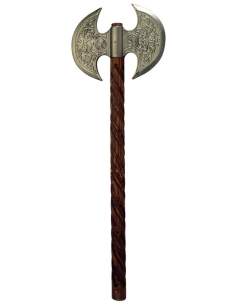Free shipping throughout Spain. International shipments to the whole world.
PERSONALIZED attention every day from 09:00 to 21:00
Medieval axes

Medieval axes
What is a tomahawk?
A battle ax is a military weapon developed from the common chopping and carving axe. Unlike the civilian axe, the military version is lighter and more stylized, and sometimes with a sharper blade.
What parts do war axes have?
Despite the simplicity of its appearance, a battle ax has several parts, the main ones being the head and handle.
The head of an ax is further divided into:
· Blade: thinnest and sharpest part, it is the one that makes the cut.
· Tip: pointed part of the blade.
· Heel: lower side of the head.
· Tongue: lower part of the head, which forms the ring hole.
· Eye: top of the head, which forms the ring hole.
· Stock: blunt end of the head.
· Cheek: widest side of the head.
The handle of war axes is also subdivided into several parts:
· Shoulder: protruding part of the handle, which serves to guarantee better support for the head.
· Throat: outer part of the handle.
· Grip: bottom of the handle.
· Handle: part used to hold the axe.
· Belly: inner part of the handle.
Where does the tomahawk come from?
Battle axes began to be manufactured in the Paleolithic, using wood and stone for their design. In the Bronze Age, axes also began to be manufactured as weapons.
What types of war axes exist?
Throughout history, new types of war axes appeared.
In the Bronze Age the following can be highlighted:
· Flat ax from the initial period of the Bronze Age (3500-1600 BC): They are solid axes, with a profile between rectangular and trapezoid, with a flattened section and a edge at one end. They are usually held with elements external to the shaft.
· Double flat ax (before 1600 BC): It was used in very technologically advanced cultures such as the Minoan or Ancient Egypt.
· Axes with developed edges (3000-1100 BC): These are more elaborate axes made from the mold in which wider and more rounded edges begin to be seen.
· Heel or butt axe with 1 or 2 rings, with or without riser (1100-700 BC): They are elongated axes with rings in the center or in the third third from their edge. These axes resemble later military hammers.
· Bucket ax (1100-700 BC): These are axes with a hollow head in which the "L" shaped shaft was embedded.
· Ax with appendages or with breastplates on its part (1100-700 BC).
During the Middle Ages, the form and process of ax manufacturing continued to develop to achieve greater efficiency and comfort in use.
The following types of medieval axes can be highlighted:
· Francisca: Traditional weapon of the West Germans, which was popularized by the Frankish people. One-handed axe, light and throwing.
· Doladera: Typical ax of the Nordic and Germanic tribes. It is wide, small and secondary in the panoply of these warriors.
· Bipenis: Double-bladed axe, which according to classical literature was a typical weapon of the legendary Amazons. The name of the weapon from Latin.
· Bulkeman: Medieval Germanic axes, rough and heavy.
· Danish or Viking: Long-horned ax used by the famous Viking people and known thanks to its forging with a special type of iron that is said to have been of meteoric origin.
· Norman: It is the typical ax represented in early medieval art. It is a shorter version and similar to those of the Franks. Without breastplates and with a developed blade and a long one-handed shaft.
· Weapon axe: Specialized and "breastplate" form of the traditional one-handed battle axe. It was forged from just one piece of metal.
· Crow beak: It is a weapon between an ax or military pick, it was characterized by uniting the "mass" of the axes with the drilling capacity of the beaks.
· Breastplate axe: Very specialized long medieval axes for infants.
· Long horned axes ("Blades"): More specialized version of horned weapons, with or without "weapon heads", with ax or breach blades.
At the end of the Western Middle Ages, medieval axes ceased to be a popular infantry weapon in favor of other more effective long pole weapons, such as cannons, and other one-man weapons, such as harquebuses and muskets.



